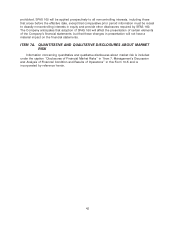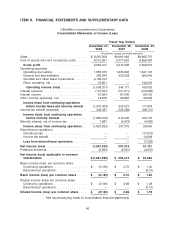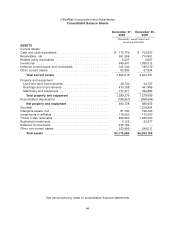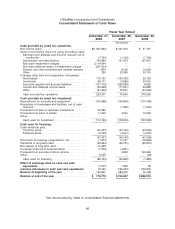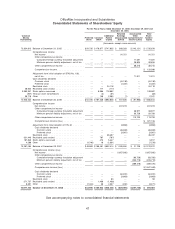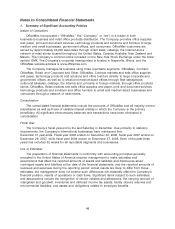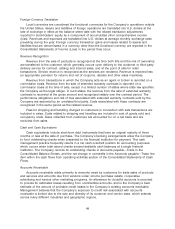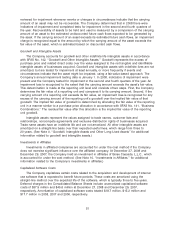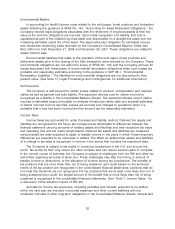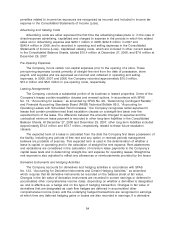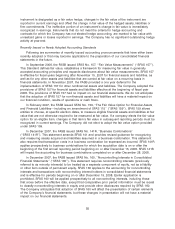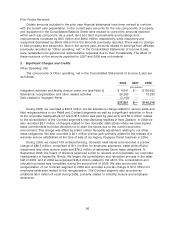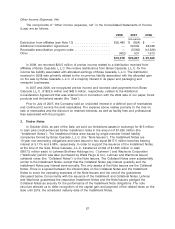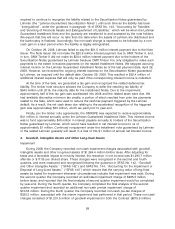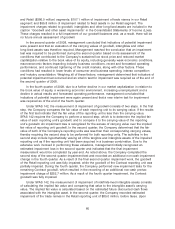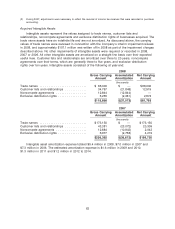OfficeMax 2008 Annual Report Download - page 56
Download and view the complete annual report
Please find page 56 of the 2008 OfficeMax annual report below. You can navigate through the pages in the report by either clicking on the pages listed below, or by using the keyword search tool below to find specific information within the annual report.Software development costs that do not meet the criteria for capitalization are expensed as
incurred.
Pension and Other Postretirement Benefits
The Company sponsors noncontributory defined benefit pension plans covering certain
terminated employees, vested employees, retirees, and some active OfficeMax, Contract
employees. The Company also sponsors various retiree medical benefit plans. The type of retiree
medical benefits and the extent of coverage vary based on employee classification, date of
retirement, location, and other factors. The Company explicitly reserves the right to amend or
terminate its retiree medical plans at any time, subject only to constraints, if any, imposed by the
terms of collective bargaining agreements. Amendment or termination may significantly affect the
amount of expense incurred.
The Company recognizes the funded status of its defined benefit pension, retiree healthcare
and other postretirement plans in the Consolidated Balance Sheets, with changes in the funded
status recognized through accumulated other comprehensive income (loss), net of tax, in the year
in which the changes occur. Actuarially-determined liabilities related to pension and postretirement
benefits are recorded based on estimates and assumptions. Key factors used in developing
estimates of these liabilities include assumptions related to discount rates, rates of return on
investments, future compensation costs, healthcare cost trends, benefit payment patterns and other
factors.
The Company measures changes in the funded status of its plans using actuarial models that
use an attribution approach that generally spreads recognition of the effects of individual events
over the estimated service lives of the employees in the plan. The attribution approach assumes
that employees render service over their service lives on a relatively smooth basis and as such,
presumes that the income statement effects of pension or postretirement benefit plans should follow
the same pattern. Net pension and postretirement benefit income or expense is also determined
using assumptions which include expected long-term rates of return on plan assets and discount
rates. The Company bases the discount rate assumption on the rates of return on high-quality
bonds currently available and expected to be available during the period to maturity of the pension
benefits. The long-term asset return assumption is based on the average rate of earnings expected
on invested funds, and considers several factors including the asset allocation, actual historical
rates of return, expected rates of return and external data.
The Company’s policy is to fund its pension plans based upon actuarial recommendations and
in accordance with applicable laws and income tax regulations. Pension benefits are primarily paid
through trusts funded by the Company. All of the Company’s postretirement medical plans are
unfunded. The Company pays postretirement benefits directly to the participants.
Facility Closure Reserves
The Company conducts regular reviews of its real estate portfolio to identify underperforming
facilities, and closes those facilities that are no longer strategically or economically viable. The
Company accounts for facility closure costs that are not related to a purchase business
combination in accordance with SFAS No. 146, ‘‘Accounting for Costs Associated with Exit or
Disposal Activities.’’ In accordance with SFAS No. 146, the Company records a liability for the cost
associated with a facility closure at its fair value in the period in which the liability is incurred, which
is the location’s cease-use date. Upon closure, unrecoverable costs are included in facility closure
reserves on the Consolidated Balance Sheets and include provisions for the present value of future
lease obligations, less contractual or estimated sublease income. Accretion expense is recognized
over the life of the payments.
52


